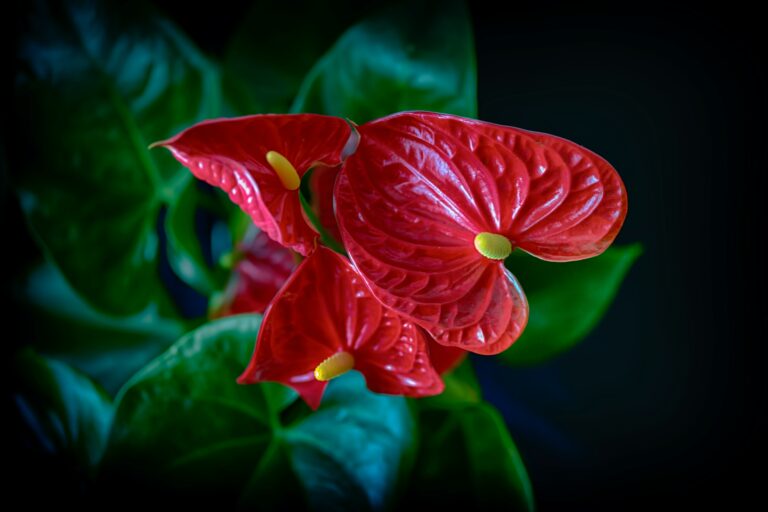Anthurium – also known as a flamingo flower – is a very popular houseplant with colorful flowers that can add a touch of tropical elegance to your home. Native to the tropical rainforests of South and Central America, they are prized for their exotic beauty and long-lasting blooms.
Anthuriums are pretty easy to care for and can thrive in various indoor environments ranging from bright, indirect light to lower light conditions. We also like them for their air-purifying properties, which can help improve indoor air quality.
Most popular Anthurium varieties:
- Anthurium veitchii (“King Anthurium”)
- Anthurium magnificum x crystallinum
- Anthurium superbum
- Anthurium ‘Ace of Spades’
Care
As mentioned above, Anthurium plants are relatively easy to care for and can stay the jewel of your home for a long time, if you pay attention to some key aspects. Just give them bright, but indirect light and well-draining, moist soil and they should be very happy.
- Soil: They need a well-draining, moist potting mix (pH range between 5.5 to 6.5) with some sand and peat moss, and may require support if they are “epiphytic” and cannot support themselves.
- Water: Anthurium plants always need some moisture, but allow the soil to dry out to the touch before watering again, which should be once a week indoors and every two or three days outdoors on hot days.
- Light: Anthurium plants prefer bright, indirect light and they thrive in sunny locations both indoors and outdoors. However, direct sunlight should be avoided.
- Temperature: Wild anthuriums generally live in temperatures at or above 60 degrees Fahrenheit, and the foliage types prefer temperatures even warmer. Indoors, they need at least 40 degrees Fahrenheit. If temperatures dip below this level, the plant will suffer.
Propagation
Anthurium plant propagation can be done from air root or stem cuttings, using a clean pot, fresh well-draining soil, and a sharp, sterilized knife or pruners. Optionally, rooting hormone can be used to increase rooting success. The stem or air root is then planted in fresh potting mix, watered thoroughly, and kept in a warm spot with indirect light for 4 to 6 weeks before new growth appears. So it is not very difficult, almost as simple as propagating a Jelly Bean plant or a Lucky Bamboo.
Pruning
When it comes to pruning anthuriums, you have the freedom to do it at any time of the year.
Grab a pair of secateurs and a plant spray filled with water, and you’re ready to go. First off, let’s get rid of any discolored or dead leaves. Say goodbye to wilted flowers too, by snipping their stems at the base. This allows the plant to redirect its energy towards producing fresh and stunning blossoms.
Next, carefully assess the anthurium plant. Trim away any leaves that disrupt its natural shape, such as those growing too tall or at odd angles. Remember not to go overboard—keep at least four leaves intact. Lastly, give your anthurium some love by misting water directly onto its leaves and stems using the plant spray.
With a little pruning and nurturing, your anthurium will flourish and reward you with its beauty.
Common pests
Frequently Asked Questions
Anthuriums thrive in locations with bright, indirect light and should be kept away from direct sunlight. They grow best in a warm environment with temperatures between 15-20°C. Water them weekly, while never letting the soil dry out completely.
Do anthuriums like sun or shade?
Anthuriums like sun more than shade, but they do best in bright, indirect light and should avoid direct sunlight.
How long do anthurium plants live?
It depends on the variety, but Anthurium plants generally live up to 5 years.
How often should I water my anthurium?
Anthuriums should be kept slightly moist and never allowed to dry out completely. Allow the top of the soil to dry out to the touch before watering again. Indoors, this is about once or max twice a week. If outside, during hot days, it can be every two or three days between waterings.
Do anthuriums like big pots?
Anthuriums don’t necessarily need a big pot. If you are re-potting them, choosing a pot slightly larger than the current pot and has good drainage is best.

